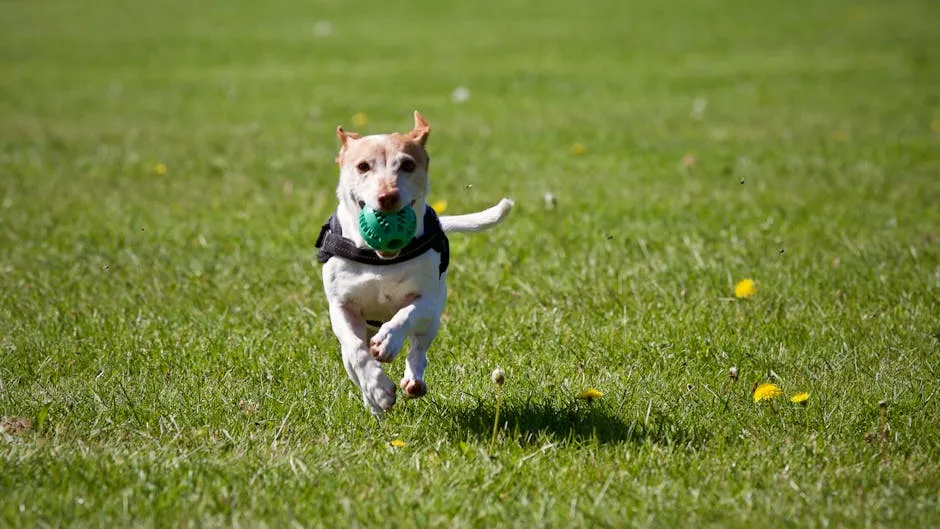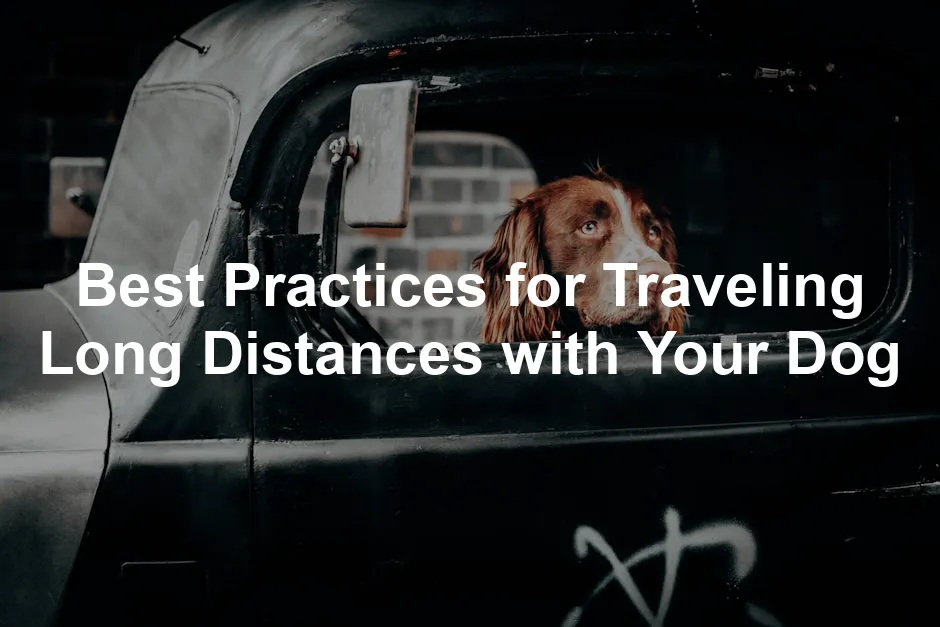Introduction
Traveling with your dog can be a thrilling adventure or a stressful experience, depending on how well you prepare. Whether you’re embarking on a cross-country road trip or just heading to a dog-friendly destination, having a plan in place is essential. A little foresight can turn your journey into a tail-wagging joyride. So, buckle up, grab the leash, and let’s hit the road—after all, the journey is just as important as the destination!
Imagine cruising down the highway with your furry co-pilot beside you, ears flapping in the wind. Sounds delightful, right? But without proper preparation, your road trip could turn into a barking nightmare. Take it from seasoned pet travelers: planning ahead is key.
Start by getting your pup acclimated to car rides. If your dog is not used to long journeys, they might feel anxious or even sick. Short practice trips can work wonders! The first few outings can be as brief as a drive around the block. Gradually increase the distance to help them adjust.
Next, ensure you have everything you need packed and ready to go. Think food, water, toys, and health records. And let’s not forget about the all-important potty breaks! Frequent stops are a must to keep your pup happy and comfortable.
Health and safety come first on the road. A visit to the vet before your trip can help catch any potential issues. Make sure your dog’s vaccinations are up-to-date, and carry their health records just in case. You might need them if you cross state lines or need to visit a veterinarian on the road.

Speaking of health and safety, have you considered a Pet First Aid Kit? It’s a must-have for any pet parent on the go! You never know when a minor mishap might occur, so being prepared with a first aid kit can offer peace of mind during your travels.
In essence, traveling with your dog can be a rewarding experience filled with fun and bonding moments. With the right planning and preparation, both you and your furry friend will enjoy the ride. So, get those tail-wagging vibes ready, and let’s dive into the essential tips for making your road trip a success!
Summary of Key Points
This article covers the best practices for traveling long distances with your dog, including how to prepare in advance, what to pack, and how to ensure a safe and enjoyable journey for both you and your pet. You will learn about the importance of acclimatizing your dog to car travel, the necessity of planning for frequent breaks, and how to maintain your dog’s routine during your trip.
Additionally, we’ll cover health and safety tips, such as keeping your dog secure in the vehicle and carrying essential documents. Remember to consider your dog’s needs, from food and water to their favorite toys. By keeping their comfort in mind, you can help reduce any travel-related stress.
Plan for regular stops every few hours to let your dog relieve themselves, stretch, and get some exercise. Research dog-friendly rest areas and parks along your route to make these breaks enjoyable.

We’ll also discuss the importance of packing a travel kit that includes your dog’s essentials, such as food, water, bowls, and health records. Don’t forget to bring a first-aid kit, just in case!
By the end of this article, you’ll be equipped with all the information you need to make your next road trip with your canine companion a memorable one. With a little preparation, you can create a journey that’s as enjoyable for your dog as it is for you. So let’s get started on making your travels a tail-wagging success!
Packing Essentials for Your Dog
A Comprehensive Packing List
When planning a long-distance trip with your furry friend, packing the right essentials is crucial. Here’s a detailed list of items you should bring along to ensure your dog’s comfort and well-being on the road:
1. Food and Water: Pack enough of your dog’s regular food for the duration of the trip, plus a little extra for any delays. Bringing bottled water is also a good idea, as unfamiliar water sources can upset their stomach.
2. Bowls: Collapsible Dog Travel Bowls are travel-friendly and easy to store. This way, your dog can stay hydrated and well-fed during breaks.
3. Bedding: Bringing your dog’s favorite bed or a familiar blanket can make all the difference. It provides comfort and a sense of security in unfamiliar places.

4. Toys: Bring a mix of familiar toys and a few new ones to keep your dog entertained. Dog Chew Toys and puzzle toys can help keep boredom at bay.
5. First-Aid Kit: A pet-specific first-aid kit is essential. Include items like bandages, antiseptic wipes, and any medications your dog may need.
6. Grooming Supplies: Pack Dog Grooming Wipes, a brush, and any other grooming tools you typically use. They’ll help keep your dog comfortable and clean during your travels.
7. Waste Bags: Always have more Dog Poop Bags than you think you’ll need. After all, nature calls at the most inconvenient times!
8. Leash and Harness: A sturdy leash and a comfortable harness are important. A harness can provide better control during stops, especially in crowded areas. Consider a Dog Seat Belt Harness for added safety during travel.
9. Health Records: Keep a copy of your dog’s vaccination records and any relevant medical information handy. Some places may require proof of vaccinations.
10. ID Tags and Microchip: Ensure your dog has an updated ID tag with your contact information. Dog Microchip Kit adds an extra layer of safety in case your dog gets lost.
11. Comfort Items: Familiar items, like your dog’s favorite toy or a piece of your clothing, can ease anxiety and help them feel more at home.
Packing these essentials ensures your dog has everything they need for a comfortable journey. Remember, a happy dog makes for a happy trip!
Safety Equipment
Safety should be a top priority when traveling with your dog. Here’s why and how to keep your furry companion secure during the ride:
1. Dog Seat Belts and Harnesses: Using a crash-tested dog seat belt or harness keeps your pet safe and secure. It prevents them from jumping around the car, which can distract you while driving.
2. Crates: Dog Travel Crates can provide a safe space for your dog during travel. Ensure the crate is large enough for them to stand, turn, and lie down comfortably. Secure the crate with a seatbelt for added safety.
3. Window Safety: While it may seem fun for your dog to stick their head out the window, it poses serious risks. Keep windows closed or only slightly open to ensure their safety from debris and sudden movements.
4. Ventilation: Ensure your car is well-ventilated. If your dog seems uncomfortable or stressed, consider adjusting the airflow or taking a break.
5. Emergency Protocols: Familiarize yourself with emergency procedures before hitting the road. Know where the nearest veterinary clinics are along your route in case of unexpected health issues.
By using the right safety equipment, you ensure a secure environment for your dog during your travels. After all, a secure pup equals a peaceful driver!

Identification and Documentation
Before you set out on your adventure, make sure your dog is properly identified and that you have all necessary documentation:
1. ID Tags: Ensure your dog wears a collar with an ID tag that includes your phone number and home address. If possible, consider a temporary tag with your destination information for the duration of your trip.
2. Microchip: A microchip is a permanent form of identification that can help reunite you with your dog if they go missing. Make sure the microchip information is up-to-date.
3. Health Records: Carry a copy of your dog’s health records, including vaccination history. This is especially important when crossing state lines or if your dog needs medical attention.
4. Emergency Contact Information: Keep a list of emergency contacts, including your veterinarian’s phone number and the nearest animal hospitals along your route. Having this information handy can save precious time in case of an emergency.
5. Travel Certificates: If you’re traveling across borders, check if a health certificate is needed. Some states may require proof of rabies vaccination as well.
Keeping your dog well-identified and having the necessary documentation ensures a smoother and safer journey. It’s all about making sure your furry friend is protected while you both enjoy the open road!
Destination Considerations
Finding Dog-Friendly Accommodations
When it comes to traveling with your dog, accommodations can make or break your trip. Start by researching hotels, motels, and vacation rentals that welcome pets. Websites like BringFido and Airbnb often have filters for pet-friendly listings. Check reviews to ensure other pet owners had a positive experience.
Look for places that provide ample space for your dog to roam. A yard or nearby park can make a significant difference. It’s also wise to contact the property directly to confirm their pet policy. Some places charge a non-refundable pet fee, so be prepared for that surprise on your bill.
You should also inquire about specific dog policies. Are there breed restrictions? Can your dog be left unattended in the room? Knowing these details can save you from last-minute stress. Some accommodations even offer dog amenities, like treats or dog beds, making your pup feel right at home.
Remember to check cancellation policies as well. If your plans change, a fully refundable booking can save you from losing money. A little research goes a long way to ensure both you and your furry friend have a comfortable stay.

And if you really want to pamper your pup, consider bringing along a Dog Travel Bed. It provides a familiar and cozy spot for them to relax after a day of adventures.
Local Laws and Regulations
Before you pack up and hit the road, familiarize yourself with local laws and regulations regarding pets. Leash laws can vary dramatically depending on where you are. Some areas require dogs to be leashed at all times, while others may have designated off-leash zones. Knowing the rules can help you avoid fines and ensure your dog’s safety.
Breed-specific legislation is another important consideration. Some cities and states have restrictions or bans on certain breeds. Researching these laws beforehand can prevent any unpleasant surprises along the way. Your dog might be the sweetest pup on the block, but a breed ban could lead to issues.
While you’re at it, find out about local dog parks or pet-friendly attractions. Many cities have parks where dogs can roam free, socialize, and burn off energy. Whether it’s a beach, a hiking trail, or a dedicated dog park, these spots can make your trip even more enjoyable. Websites and apps like Dog Park Finder can help you locate nearby parks.
Incorporating this information into your travel plans will ensure a smooth experience for both you and your canine companion. After all, a well-informed traveler is a happy traveler!

FAQs
How often should I stop for breaks during a long road trip with my dog?
It is recommended to stop every 2-3 hours to allow your dog to relieve themselves and stretch. These breaks help prevent restlessness and keep your pup happy. Use this time for a quick walk or a game of fetch. It’s a win-win!
What should I do if my dog gets car sick?
Consult your vet for possible solutions, including medications or calming aids. A light meal a few hours before travel can also help reduce the chances of car sickness. Remember, a happy tummy leads to a happy pup!
Is it safe to leave my dog in the car while I run errands?
No, it is unsafe to leave your dog alone in the car, especially in warm weather. Temperatures can rise quickly, leading to heatstroke. If you can’t take your dog inside with you, consider alternatives like pet-friendly shops or cafes.
How can I keep my dog entertained during the trip?
Bring along chew toys, puzzle games, and treats to keep your dog engaged. Regular breaks for playtime are also beneficial. A tired dog is a well-behaved dog, after all! Mix it up with new toys to keep things exciting.
What should I do if my dog gets lost during the trip?
Ensure your dog has a collar with an ID tag and is microchipped. Carry recent photos of your dog to assist local shelters if needed. The more prepared you are, the easier it will be to find your furry friend if they wander off.
Should I stick to my dog’s regular feeding schedule while traveling?
Yes, try to maintain your dog’s regular feeding schedule as closely as possible. If you must feed them on the road, do it during a stop, not while driving. This helps avoid tummy troubles and keeps your dog feeling secure.
Can I travel with my dog on public transport?
Many public transport systems allow dogs, but rules vary by location. Check the specific pet policies for the train, bus, or ferry you plan to use. Always have your dog leashed and be respectful of other passengers.
What health documents should I carry for my dog while traveling?
Carry your dog’s vaccination records and any necessary health certificates, especially if crossing state lines. It’s also wise to have a list of emergency veterinary contacts along your route. You never know when you might need them!
How do I prepare my dog for a long car ride?
Acclimate your dog to car travel with short trips. Gradually increase the distance to help them adjust. Create positive associations by rewarding them with treats or praise after each trip. This will help them feel more comfortable during longer journeys.
What should I do if my dog gets lost during the trip?
Losing your dog while traveling can be a pet owner’s worst nightmare. To minimize this risk, make sure your dog has a collar with an ID tag that includes your contact information. It’s like a business card for your furry friend! In addition to the collar, get your dog microchipped. This permanent form of identification will help reunite you if they wander off. Before your trip, take recent photos of your dog. These pictures will be invaluable if you need to share them with local shelters or post on social media. If your dog goes missing, immediately notify nearby shelters and veterinary clinics. The faster you spread the word, the better the chances of finding your pup. Lastly, stay calm. Panic won’t help, and your dog can sense your stress. Instead, focus on getting the word out and retracing your steps. Remember, preparation is key! Following these steps can give you peace of mind while you hit the road with your four-legged co-pilot.
Please let us know what you think about our content by leaving a comment down below!
Thank you for reading till here 🙂
All images from Pexels





